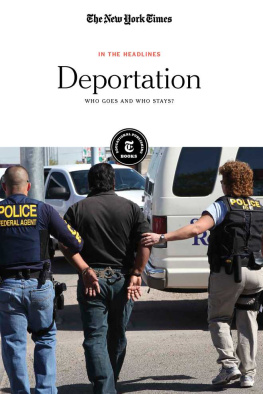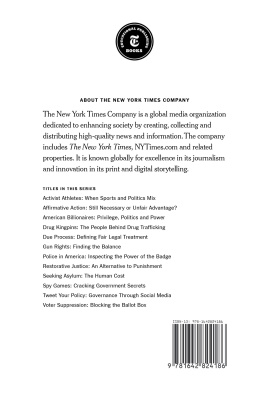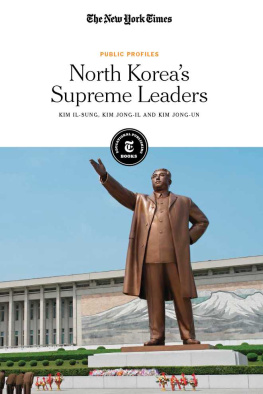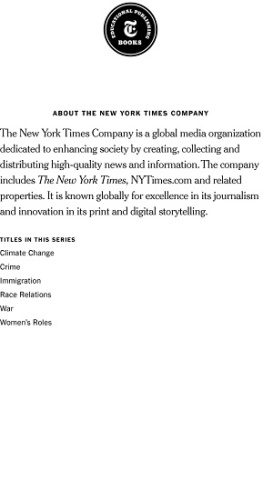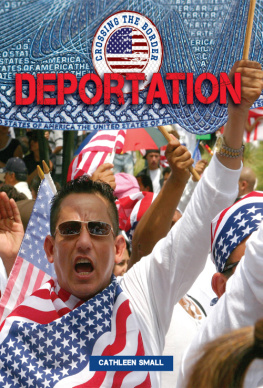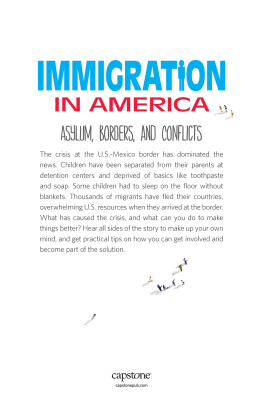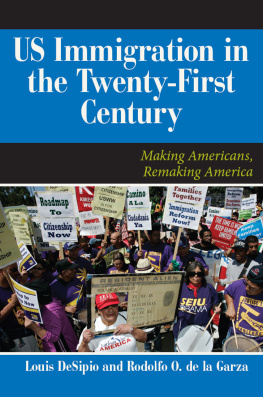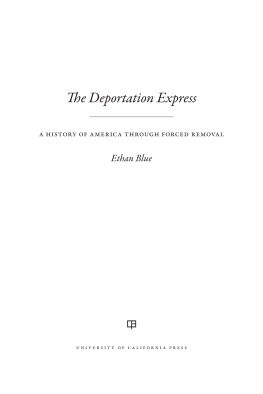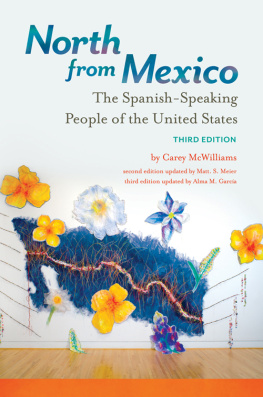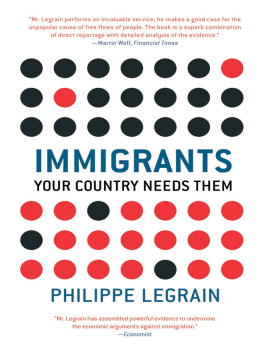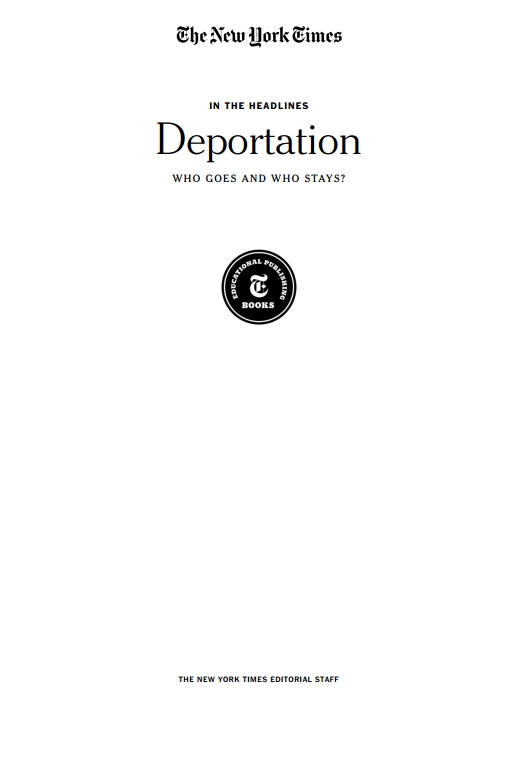Published in 2019 by The New York Times Educational Publishing in association with The Rosen Publishing Group, Inc.
29 East 21st Street, New York, NY 10010
Contains material from The New York Times and is reprinted by permission. Copyright 2019 The New York Times. All rights reserved.
Rosen Publishing materials copyright 2019 The Rosen Publishing Group, Inc. All rights reserved. Distributed exclusively by Rosen Publishing.
First Edition
The New York Times
Alex Ward: Editorial Director, Book Development Phyllis Collazo: Photo Rights/Permissions Editor Heidi Giovine: Administrative Manager
Rosen Publishing
Megan Kellerman: Managing Editor Marcia Amidon Lusted: Editor Greg Tucker: Creative Director Brian Garvey: Art Director
Cataloging-in-Publication Data
Names: New York Times Company.
Title: Deportation: who goes and who stays? / edited by the New York Times editorial staff.
Description: New York : New York Times Educational Publishing, 2019. | Series: In the headlines | Includes glossary and index. Identifiers: ISBN 9781642821123 (library bound) | ISBN 9781642821116 (pbk.) | ISBN 9781642821130 (ebook)
Subjects: LCSH: Illegal aliensGovernment policyUnited StatesJuvenile literature. | Deportation United States Juvenile literature. | Immigration enforcementUnited StatesJuvenile literature. | United StatesEmigration and immigration Government policyJuvenile literature. Classification: LCC JV6483.D476 2019 | DDC 364.6'8dc23
Manufactured in the United States of America
On the cover: Immigration officials make an arrest in April 2010 at a shuttle business in Tucson, Ariz. believed to be part of a smuggling ring; Monica Almeida/The New York Times.
Contents
Introduction
immigration has been a reoccurring and often controversial issue since before the founding of the United States as a country. While the United States has long cherished its representation as a melting pot, a place where many nationalities, races and cultures have come together and blended into a strong, new whole, the reality is that immigration has often created strong feelings as to who should be considered a real American and who should not. Even the language used to convey the status of someone who is not American-born is derogatory: They are called resident aliens or illegal aliens, even in government literature. It almost seems a contradiction that the Statue of Liberty, one of the first sites that once welcomed immigrants to the United States, has a plaque on its base with the sonnet New Colossus by Emma Lazarus, which includes the line, Give me your tired, your poor, your huddled masses yearning to breathe free.
The reality of what immigrants encounter when entering the United States is rarely welcoming. Throughout history, immigrants have experienced varying degrees of official scrutiny in order to move to the United States and become residents. Their numbers were extremely high, especially as a result of events such as world wars, the Holocaust, the Irish potato famine and other catastrophic political, religious and natural disasters that forced people to flee intolerable living conditions.
Between 1892 and 1954, when Ellis Island in New York City was the busiest station in the country for arriving immigrants, 12 million people were processed there alone. Those who succeeded in gaining entry often faced a new round of discrimination from established Americans. Ethnic groups such as the Irish were characterized as lazy, unintelligent, criminal and alcoholic, and were often discriminated against in hiring by the words No Irish Need Apply. They resorted to jobs such as digging ditches, laying rail lines, cleaning houses and working in mills, all for low pay. Working-class Americans feared that Irish immigrants were taking jobs away from them. Even their religion, Catholicism, put them at odds with American Protestants. Ultimately, people who shared anti-Catholic and anti-immigration sentiments formed the American Party, whose members vowed only to elect native-born citizens to office. Their slogans included Americans must rule America!
Oddly, these 19th-century immigration issues have never really gone away, and the question of who should be allowed to stay in the United States and who should be forced to leave has always simmered below the surface. Racism, religious intolerance and other factors have contributed to anti-immigration sentiments and have been widely debated. During the 2016 presidential campaign, candidate Donald Trump won many followers with his stance on immigration: mainly that immigrants (especially those who were in the country illegally) were taking jobs away from Americans, clogging the social welfare system, and generating much of the crime in the United States.
One of Trumps first actions after his inauguration as president was to issue a series of executive orders banning the admission of anyone from seven primarily Muslim countries into the United States, as well as any refugees from Syria, and granting immigration priority to Christians over Muslims. This action created chaos in the nations major international airports, as people flying into the United States, some with legitimate visas, were refused entry. The travel ban initiated by Trump was temporarily rescinded, but was upheld by the Supreme Court in June 2018.
President Trump, a vocal opponent of many forms of immigration, said in May 2018: [The United States has] the dumbest laws on immigration in the world. We have people coming into the country or trying to come in were stopping a lot of them. You wouldnt believe how bad these people are. These arent people, these are animals, and were taking them out of the country at a level and a rate thats never happened before.

STEPHEN CROWLEY/THE NEW YORK TIMES
President Donald Trump signs an executive order on immigration at the Pentagon in Arlington, Va., on Jan. 27, 2017. For the president, the chaos of the travel ban and the subsequent legal challenges were the first, sharp evidence that he could exert power over a federal bureaucracy he had criticized on the campaign trail.
The question of immigration, and especially who should be allowed to come to the United States, who should remain here, and who should be deported and sent back to their countries of origin is a controversial and divisive issue. People are intensely divided as to how they feel, sometimes to the point of violence. There are far-reaching implications to welcoming or barring people from the country who might actually bring their own wealth of knowledge and ability to contribute to the United States. It is not an issue that can be easily resolved or even easily discussed.
Chapter 1
Immigration Controversy
Since the election of President Donald Trump in 2016, controversy and fear surrounding immigration to the United States has grown intensely. While some feel immigrants should be able to start new lives here and that they make meaningful contributions to American society, others feel immigrants, especially illegal ones, take jobs away from Americans, as well as receive health care and other social welfare benefits. The discussion divides the country every day, and confusion surrounding the Trump administration's immigration policy has further complicated the issue.

